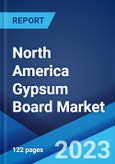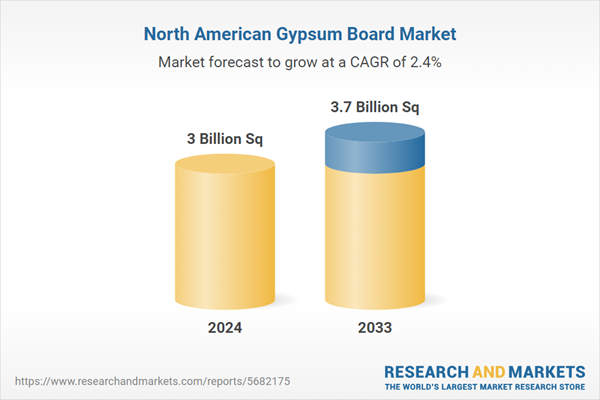North America Gypsum Board Market Analysis:
- Market Growth and Size: The North America gypsum board market was valued at 2.9 billion square meters in 2023, poised to reach 3.6 billion square meters by 2032. This steady growth is a clear indicator of the robust demand in the construction and renovation sectors, reflecting the industry's resilience and potential.
- Major Market Drivers: The market thrives on the escalating demand for engineered materials and the prevalent use of gypsum boards in wood-frame constructions. Additionally, the sector is buoyed by the momentum of renovation and modernization projects, highlighting its pivotal role in the evolving construction landscape.
- Technological Advancements: Innovations in manufacturing, such as improved soundproofing and fire resistance, propel the market forward. These technological strides are revolutionizing the industry, enhancing product quality and operational efficiency.
- Industry Applications: Extensively utilized in various domains, gypsum boards are synonymous with versatility and functionality, especially valued for their acoustic control and ease of installation. Their application underscores a commitment to safety and aesthetics, cementing their status in modern construction.
- Key Market Trends: The tilt towards sustainable and green building materials is reshaping the market, with gypsum boards leading the charge due to their environmental benefits. This trend reflects a growing consciousness towards eco-friendly construction practices, mirroring the industry's adaptation to global sustainability goals.
- Geographical Trends: Dominance of the U.S. market is complemented by significant contributions from Canada and Mexico, shaping the regional market dynamics. This geographical spread is testament to the adaptability and widespread acceptance of gypsum boards across varied construction landscapes.
- Competitive Landscape: A landscape marked by strategic collaborations and innovations showcases the competitive spirit of the market. This environment stimulates continual advancements, ensuring that the industry remains at the forefront of construction material technology.
- Challenges and Opportunities: Industry players navigate challenges like volatile raw material costs and the imperative for technological adaptability. However, the burgeoning demand for sustainable and high-quality construction materials unveils vast opportunities, heralding a phase of expansive growth and innovation.
The market in North America is majorly driven by the rising influx of engineered products, such as gypsum board, in the construction industry. Apart from this, several renovation and restoration projects for structural complexes have fueled the growth of the gypsum board market. In addition to this, the wood-frame construction, which is prevalent in the region, uses gypsum boards as an essential component. Furthermore, abundance of natural gypsum reserves and the presence of multiple synthetic gypsum suppliers in the region have also spurred the demand for gypsum board.
Key Market Segmentation:
The publisher provides an analysis of the key trends in each segment of the North America gypsum board market report, along with forecasts at the regional and country levels from 2025-2033. Our report has categorized the market based on product type and end-use.- Key Regions Analysed
- United States
- Canada
- Mexico
- Analysis for Each Country
- Market by Product Type
- Wallboard
- Ceiling Board
- Pre-decorated Board
- Others
- Market by End-Use
- Residential
- Corporate
- Commercial
- Institutional
- Value Chain Analysis
- Key Drivers and Challenges
- Porters Five Forces Analysis
- PESTEL Analysis
- Government Regulations
- Competitive Landscape
- Competitive Structure
- Key Player Profiles
Key Questions Answered in This Report:
- How has the North America gypsum board market performed so far and how will it perform in the coming years?
- What are the key regions in the North America gypsum board market?
- What has been the impact of COVID-19 on the North America gypsum board market?
- What is the breakup of the North America gypsum board market on the basis of product type?
- What is the breakup of the North America gypsum board market on the basis of end-use?
- What are the various stages in the value chain of the North America gypsum board industry?
- What are the key driving factors and challenges in the North America gypsum board industry?
- What is the structure of the North America gypsum board industry and who are the key players?
- What is the degree of competition in the North America gypsum board industry?
- What are the profit margins in the North America gypsum board industry?
Table of Contents
1 Preface2 Scope and Methodology
2.1 Objectives of the Study
2.2 Stakeholders
2.3 Data Sources
2.3.1 Primary Sources
2.3.2 Secondary Sources
2.4 Market Estimation
2.4.1 Bottom-Up Approach
2.4.2 Top-Down Approach
2.5 Forecasting Methodology
3 Executive Summary
4 Introduction
4.1 Overview
4.2 Key Industry Trends
5 Global Gypsum Board Market
5.1 Market Performance
5.2 Market Breakup by Product Type
5.3 Market Breakup by End-Use
5.4 Market Breakup by Region
5.5 Market Forecast
6 North America Gypsum Board Market
6.1 Market Performance
6.2 Impact of COVID-19
6.3 Market Forecast
7 North America Gypsum Board Market: Breakup by Product Type
7.1 Wallboard
7.2 Ceiling Board
7.3 Pre-decorated Board
7.4 Others
8 North America Gypsum Board Market: Breakup by End-Use
8.1 Residential
8.2 Corporate
8.3 Commercial
8.4 Institutional
9 North America Gypsum Board Market: Breakup by Country
9.1 United States
9.1.1 Historical Market Trends
9.1.2 Market Breakup by Product Type
9.1.3 Market Breakup by End-Use
9.1.4 Market Forecast
9.2 Canada
9.2.1 Historical Market Trends
9.2.2 Market Breakup by Product Type
9.2.3 Market Breakup by End-Use
9.2.4 Market Forecast
9.3 Mexico
9.3.1 Historical Market Trends
9.3.2 Market Breakup by Product Type
9.3.3 Market Breakup by End-Use
9.3.4 Market Forecast
10 SWOT Analysis
10.1 Overview
10.2 Strengths
10.3 Weaknesses
10.4 Opportunities
10.5 Threats
11 Value Chain Analysis
11.1 Overview
11.2 Raw Material Procurement
11.3 Manufacturing
11.4 Marketing
11.5 Distribution
11.6 Retailer/Exporter
11.7 End-User
12 Porter’s Five Forces Analysis
12.1 Overview
12.2 Bargaining Power of Buyers
12.3 Bargaining Power of Suppliers
12.4 Degree of Rivalry
12.5 Threat of New Entrants
12.6 Threat of Substitutes
13 Price Analysis
14 Competitive Landscape
14.1 Market Structure
14.2 Key Players
14.3 Profiles of Key Players
List of Figures
Figure 1: North America: Gypsum Board Market: Major Drivers and Challenges
Figure 2: Global: Gypsum Board Market: Value Trends (in Billion USD), 2019-2024
Figure 3: Global: Gypsum Board Market: Breakup by Product Type (in %), 2024
Figure 4: Global: Gypsum Board Market: Breakup by End-Use (in %), 2024
Figure 5: Global: Gypsum Board Market: Breakup by Region (in %), 2024
Figure 6: Global: Gypsum Board Market Forecast: Value Trends (in Billion USD), 2025-2033
Figure 7: North America: Gypsum Board Market: Volume Trends (in Billion Sq. Meters), 2019-2024
Figure 8: North America: Gypsum Board Market Forecast: Volume Trends (in Billion Sq. Meters), 2025-2033
Figure 9: North America: Gypsum Board Market: Breakup by Product Type (in %), 2024
Figure 10: North America: Gypsum Board (Wallboard) Market: Volume Trends (in Billion Sq. Meters), 2019 & 2024
Figure 11: North America: Gypsum Board (Wallboard) Market Forecast: Volume Trends (in Billion Sq. Meters), 2025-2033
Figure 12: North America: Gypsum Board (Ceiling Board) Market: Volume Trends (in Billion Sq. Meters), 2019 & 2024
Figure 13: North America: Gypsum Board (Ceiling Board) Market Forecast: Volume Trends (in Billion Sq. Meters), 2025-2033
Figure 14: North America: Gypsum Board (Pre-decorated Board) Market: Volume Trends (in Billion Sq. Meters), 2019 & 2024
Figure 15: North America: Gypsum Board (Pre-decorated Board) Market Forecast: Volume Trends (in Billion Sq. Meters), 2025-2033
Figure 16: North America: Gypsum Board (Other Product Types) Market: Volume Trends (in Billion Sq. Meters), 2019 & 2024
Figure 17: North America: Gypsum Board (Other Product Types) Market Forecast: Volume Trends (in Billion Sq. Meters), 2025-2033
Figure 18: North America: Gypsum Board Market: Breakup by End-Use (in %), 2024
Figure 19: North America: Gypsum Board (Residential) Market: Volume Trends (in Billion Sq. Meters), 2019 & 2024
Figure 20: North America: Gypsum Board (Residential) Market Forecast: Volume Trends (in Billion Sq. Meters), 2025-2033
Figure 21: North America: Gypsum Board (Corporate) Market: Volume Trends (in Billion Sq. Meters), 2019 & 2024
Figure 22: North America: Gypsum Board (Corporate) Market Forecast: Volume Trends (in Billion Sq. Meters), 2025-2033
Figure 23: North America: Gypsum Board (Commercial) Market: Volume Trends (in Billion Sq. Meters), 2019 & 2024
Figure 24: North America: Gypsum Board (Commercial) Market Forecast: Volume Trends (in Billion Sq. Meters), 2025-2033
Figure 25: North America: Gypsum Board (Institutional) Market: Volume Trends (in Billion Sq. Meters), 2019 & 2024
Figure 26: North America: Gypsum Board (Institutional) Market Forecast: Volume Trends (in Billion Sq. Meters), 2025-2033
Figure 27: North America: Gypsum Board Market: Breakup by Country (in %), 2024
Figure 28: United States: Gypsum Board Market: Volume Trends (in Billion Sq. Meters), 2019-2024
Figure 29: United States: Gypsum Board Market: Breakup by Product Type (in %), 2024
Figure 30: United States: Gypsum Board Market: Breakup by End-Use (in %), 2024
Figure 31: United States: Gypsum Board Market Forecast: Volume Trends (in Billion Sq. Meters), 2025-2033
Figure 32: Canada: Gypsum Board Market: Volume Trends (in Billion Sq. Meters), 2019-2024
Figure 33: Canada: Gypsum Board Market: Breakup by Product Type (in %), 2024
Figure 34: Canada: Gypsum Board Market: Breakup by End-Use (in %), 2024
Figure 35: Canada: Gypsum Board Market Forecast: Volume Trends (in Billion Sq. Meters), 2025-2033
Figure 36: Mexico: Gypsum Board Market: Volume Trends (in Billion Sq. Meters), 2019-2024
Figure 37: Mexico: Gypsum Board Market: Breakup by Product Type (in %), 2024
Figure 38: Mexico: Gypsum Board Market: Breakup by End-Use (in %), 2024
Figure 39: Mexico: Gypsum Board Market Forecast: Volume Trends (in Billion Sq. Meters), 2025-2033
Figure 40: North America: Gypsum Board Industry: SWOT Analysis
Figure 41: North America: Gypsum Board Industry: Value Chain Analysis
Figure 42: North America: Gypsum Board Industry: Porter’s Five Forces Analysis
List of Tables
Table 1: North America: Gypsum Board Market: Key Industry Highlights, 2024 and 2033
Table 2: North America: Gypsum Board Market Forecast: Breakup by Product Type (in Billion Sq. Meters), 2025-2033
Table 3: North America: Gypsum Board Market Forecast: Breakup by End-Use (in Billion Sq. Meters), 2025-2033
Table 4: North America: Gypsum Board Market Forecast: Breakup by Country (in Billion Sq. Meters), 2025-2033
Table 5: North America: Gypsum Board Market: Competitive Structure
Table 6: North America: Gypsum Board Market: Key Players
Table Information
| Report Attribute | Details |
|---|---|
| No. of Pages | 123 |
| Published | August 2025 |
| Forecast Period | 2024 - 2033 |
| Estimated Market Value in 2024 | 3 Billion Sq |
| Forecasted Market Value by 2033 | 3.7 Billion Sq |
| Compound Annual Growth Rate | 2.4% |
| Regions Covered | North America |









